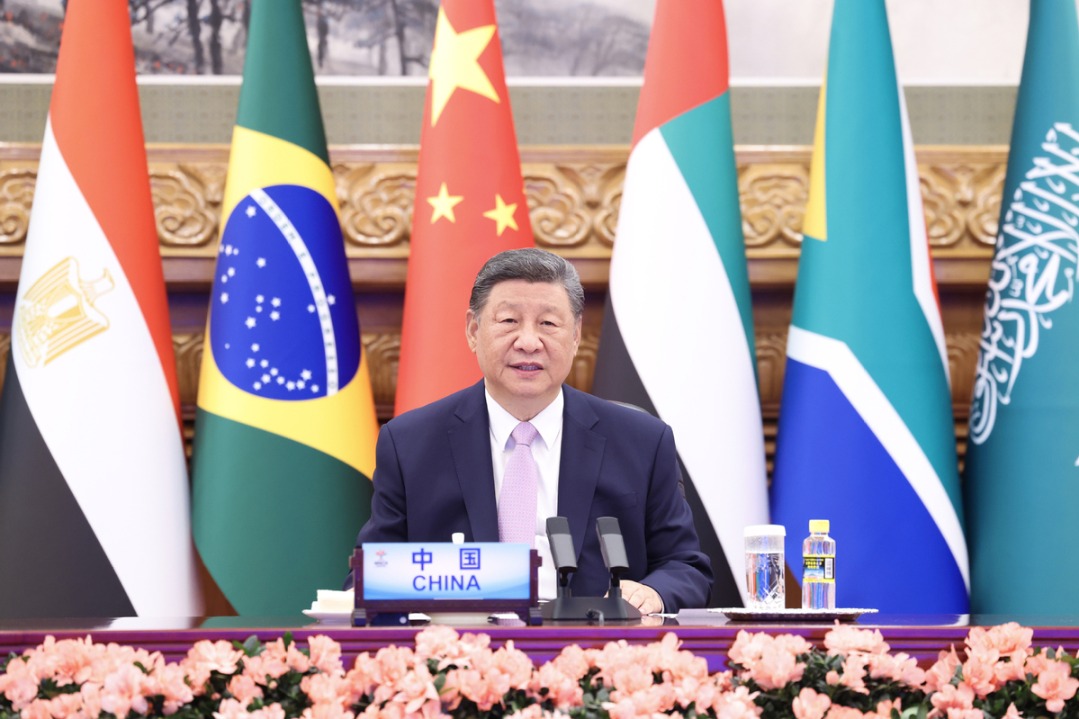China's enduring strengths for long-term growth

The strategic rivalry between China and the United States is a protracted one, the nature and duration of which are not determined by China's will alone.
Through decades of persistent and unwavering efforts, China has laid a solid foundation. This very foundation has provided the confidence for China to engage in strategic defense, and exercise strategic countermeasures against the US. It serves as a crucial base for China to maintain its strategic endurance.
To begin with, China possesses strong institutional strengths. The five-year plan is a unique and important method of governance created by China. Since the founding of New China, a total of 14 five-year plans have been formulated and implemented so far.
During the 12th Five-Year Plan (2011-15), China's total economic output ranked second in the world, contributing more than 25 percent to global economic growth. In the 13th Five-Year Plan (2016-20), China's economy grew from less than 70 trillion yuan ($9.75 trillion) to over 100 trillion yuan, achieving a moderately prosperous society and resolving absolute poverty.
The 14th Five-Year Plan (2021-25) marks the beginning of a new journey to fully build a modern socialist country. Despite the challenges of a three-year pandemic, major-power competition with the US and regional conflicts, economic and social development has generally progressed as expected.
China has also been building a comprehensive innovation ecosystem. On the national level, the innovation system includes three key components — national laboratories, key national laboratories and comprehensive national science centers.
Meanwhile, China has been strengthening the key role of enterprises as innovation drivers. In 2023, a total of 142 Chinese firms were listed among the Fortune Global 500, marking the highest number from any country.
China's total spending on research and development has increased significantly, rising from 1.03 trillion yuan in 2012 to 3.6 trillion yuan in 2024. The R&D intensity ratio — R&D spending as a percentage of GDP — grew from 1.91 percent to 2.68 percent during this period.
In 2021, China accounted for 27.5 percent of global R&D expenditure, while the US spent $607.5 billion, representing 35.6 percent of the global total. Chinese enterprises have played a dominant role in driving innovation, contributing more than 75 percent of the nation's total R&D spending for several years running.
China has also built a robust digital infrastructure over the past decades. As of the end of June, the nation had constructed more than 4.55 million 5G base stations, accounting for 67 percent of the global total. The number of 5G users in the country stood at about 1.12 billion, with 5G traffic representing over 79 percent of total mobile data usage.
The Ministry of Industry and Information Technology said 5G technology has been integrated into 80 out of 97 major categories of the national economy. The number of "5G+ Industrial Internet" projects has surpassed 18,500, achieving full coverage across 41 industrial sectors.
Additionally, China has established 700 high-level 5G-enabled smart factories, demonstrating the profound integration of advanced connectivity technologies into modern manufacturing and economic activities.
Major economies worldwide are accelerating their efforts in 6G R&D. China initiated 6G research as early as 2019. Currently, China holds 39.8 percent of global 6G-related patent applications, followed by the US with 35.2 percent and Japan with 9.9 percent.
China has become the world's largest manufacturing nation. The US, Germany, Japan, the United Kingdom, France, Sweden, South Korea, Italy and Canada have long held leading positions in high-end manufacturing and cutting-edge technology industries. However, in 2024, China's manufacturing output accounted for 31.6 percent of the global total — equivalent to the combined output of the aforementioned nations.
China's value-added manufacturing output reached 40.5 trillion yuan in 2024, maintaining its position as the world's largest manufacturing economy for the 15th consecutive year. Among 500 major industrial products, China ranks first globally in the output of more than 220 categories.
High-tech manufacturing is accelerating China's industrial transformation. In 2024, production and sales of new energy vehicles increased 34.4 percent year-on-year; solar power installation capacity grew 45.2 percent; and output of automotive-use lithiumion batteries rose 27.2 percent.
China has installed more industrial robots than the rest of the world combined. As of July 2024, the country held over 190,000 related patents — accounting for about two-thirds of the global total — spanning industrial, specialized and service robotics. For 11 consecutive years, China has remained the world's largest market for industrial robots.
China's semiconductor sector is now among the fastest-catching-up industries globally. In 2024, the country's semiconductor exports reached 1.14 trillion yuan, making chips a major export. Daily output averaged 1.2 billion units, with annual production surpassing 430 billion units.
These advances underscore China's shifting focus from scale to innovation-driven, sustainable industrial leadership.
The tariff war initiated by the US posed significant challenges and shocks to the world. In response, China adopted firm and effective countermeasures, safeguarding the stability of the global economic system, the international trade framework, and industrial and supply chains.
By upholding multilateralism and free trade, China has emerged as a key stabilizing force for world peace and development amid growing uncertainties.
Despite trade tensions between China and the US, the world's two largest economies remain deeply intertwined, with the US market exhibiting a strong dependence on China's manufacturing sector that would be extremely costly for Washington to unravel.
The sheer scale of the trade volume last year between China and the US — about $700 billion — speaks for itself. This isn't a product of one-sided pressure. It's a reflection of deep-seated market needs and mutual economic benefit for both sides of the Pacific.
The two countries' complementary strengths and the vast potential for cooperation are clear, but the key lies in genuine equality and good faith at the negotiating table to seek new collaboration models.
China's door to talks with the US about their trade dispute is always open, but China will not yield on key issues of principle.
The writer is former chief economist at the China Center for International Economic Exchanges.
The views do not necessarily reflect those of China Daily.

Today's Top News
- Xi extends congratulations to Kim over DPRK's 77th founding anniversary
- Xi meets Portuguese prime minister
- Autonomous regions making good progress on multiple fronts
- Trade fair highlights broadened opening-up
- New markets to spur foreign trade
- Global Governance Initiative a timely call






























